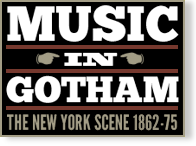Thomas Central Park Garden Concert
Event Information
Venue(s):
Central Park Garden
Proprietor / Lessee:
John Koch
Conductor(s):
Theodore Thomas [see also Thomas Orchestra]
Price: $.50; $1 & $2 extra, private boxes
Event Type:
Orchestral
Record Information
Status:
Published
Last Updated:
28 June 2025
Performance Date(s) and Time(s)
02 Jun 1875, 8:00 PMPerformers and/or Works Performed
Citations
“Thomas’s Concerts at the Central Park Garden have never been finer than they are now—never more remarkable for the beauty and spirit of the performance, of the variety and interest of the programmes, and never more keenly enjoyed by that part of the public which has any pretention to musical taste. Among the recent selections have been the whole of Raff’s ‘Lenore’ Symphony, the new ‘Hungarian Rhapsody,’ No. 1, which has become highly popular; the charming Intermezzo, ‘Elves of Light and Frost Giants,’ from Hofmann’s ‘Frithiof’ Symphony; the ballet music from ‘Robert;’ the favorite allegretto from Mozart’s E flat symphony; and the superb arrangements from ‘The Flying Dutchman’ and the first Act of ‘Lohengrin.’ The latest novelties are an orchestral Rhapsody by Raff, and a Symphonic Poem by Saint Saens. The Raff composition, entitled ‘Evening,’ has none of the freedom, not to say extravagance of style, which we naturally associate with the designation of a rhapsody; it is rather in the calm, gentle, and melodious spirit of a romanza,--a graceful work distinguished as Raff’s writing almost always is for careful construction and excellent instrumentation. It was first heard at one of Thomas’s matinee concerts during the winter. The Symphonic Poem by Saint Saens (Op. 31,) however, had never been played in New-York until last week. It is called ‘Le Rouet d’Omphale’ (Omphale’s Spinning-wheel,) and illustrates the myth of Hercules serving as a slave to the Lydian queen and wearing female attire as he sits spinning by her side. It begins with an elegant little movement in which the music of the wheel and distaff is very happily imitated, chiefly by the violins. Then there is a second part, a broad and highly colored monody in a minor key, which, of course, represents the disgraced hero’s lament. But Omphale, as we know, used to rap Hercules over the knuckles with her slipper when his spinning did not suit her, so the lament soon comes to an end, and the buzz of the wheel is resumed. The Symphonic Poem is short, bright, neat, and lively, and a good specimen of the very best French style. It was interesting to contrast it, as we had several opportunities to do last week, with the finest of all the many spinning-wheel songs, that in Wagner’s ‘Flying Dutchman.’”

